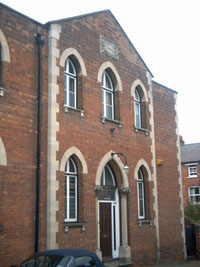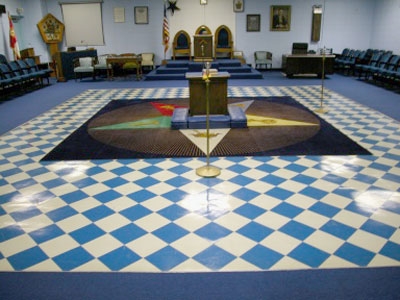Many people wonder whether the Freemasons are a religious organization. Although they claim to be no more religious than any Rotary Club or other social organization, their rituals do have strong spiritual overtones.
|
The Shriners
In 1870, a new organization formed out of the Freemasons, which was called "The Ancient Arabic Order of Nobles of the Mystic Shrine," or the "Shriners." To become a Shriner, a man must first rise to the Third Degree (Mastor Mason) in the Blue Lodge. After becoming a Master Mason, a man can belong to any Masonic group that has Blue Lodge Masonry as a prerequisite. The Shriners are known for their:
- signature red fezzes - a tribute to the organization’s Arabic heritage
- fun attitude - they are often clowns in circuses and parades
- greatphilanthropy- Shriners hospitals around the country provide free care to children
|
People of all religions are free to join the Freemasons, and religion is never overtly discussed during meetings. However, every member must profess a belief in a universal Supreme Being, whom the Freemasons refer to as the "Great Architect of the Universe." As is the case with most religions, Masons are expected to be morally upright individuals. Members swear oaths to the Book of the Sacred Law, which, depending on the Lodge, can be the Jewish Old Testament, the Christian New Testament or even the Islamic Koran.
Entering the Brotherhood
Given the clandestine nature of the Freemasons, it's not surprising that they give careful consideration before admitting new members. To join, a man must fill out a petition and obtain two sponsors within the Lodge. He will then be voted in by secret ballot. Potential new members are asked whether they believe in God, and they must answer "yes" to be admitted. Although they don't have to be wealthy, members must have enoughmoneyto pay membership fees and to make the regularcharitabledonations that are expected of all Freemasons.
New Freemasons start out as Entered Apprentices. During the initiation ceremony, the Freemasons recount the building of King Solomon's Temple and the murder of Hiram Abiff. The new member is blindfolded and confronted by three men, who order him to reveal the Freemasons' secrets. He swears he will not tell, and then pretends to die and be resurrected into Masonry.
Freemasons must then rise through two more degrees, Freecraft Mason and Master Mason, after they have become proficient in the lessons of the previous degree. As a member rises through the degrees, he becomes privy to more and more of the Freemasons' secrets.
 Photo courtesy ofJahrundert
Freemason initiation ceremony, 18th century.
Photo courtesy ofJahrundert
Freemason initiation ceremony, 18th century.
After completing the Master Mason degree, a member can reach the Supreme Order of the Holy Royal Arch, at which time the name of the Great Architect of the Universe is finally revealed to him. The name is reportedly Jahbulon—Jah for Jahweh, the God of the Hebrews; Bul for Baal, the ancient Canaanite fertility god who was considered evil for competing with Jahweh for the Israelites' allegiance; and On for Osiris, the ancient Egyptian god of the underworld.
Freemasons at each level swear never to reveal the Freemasons' secrets. The punishments for doing so become progressively more severe with each successive level. An Apprentice Mason's tongue is torn out; a Freecraft Mason'sheartis torn out; a Master Mason's bowels are burned; and a Royal Arch has the top of his skull sliced off (many Masons dispute this claim, however, saying that their rites are nowhere near this sinister).
尽管大多数共济会从未进步过去的水平three, most sources agree that there are 33 degrees in total. The York Rite includes only the first 13 of these levels, and they differ from the Scottish Rite. They may also differ from jurisdiction to jurisdiction:
|
33 Degrees of the Freemasons
|
|
1. Entered Apprentice |
12. Grand Master Architect |
23. Chief of the Tabernacle |
|
2. Fellow Craft |
13. Royal Arch of Enoch |
24. Prince of the Tabernacle |
|
3. Master Mason |
14. Scottish Knight of Perfection |
25. King of the Brazen Serpent |
|
4. Secret Master |
15. Knight of the Sword, or of the East |
26. Prince of Mercy |
|
5. Perfect Master |
16. Prince of Jerusalem |
27. Commander of the Temple |
|
6. Intimate Secretary |
17. Knight of the East and West |
28. Knight of the Sun |
|
7. Provost and Judge |
18. Knight of the Pelican and Eagle and Sovereign Prince Rose Croix of Heredom |
29. Knight of St. Andrew |
|
8. Intendant of the Building |
19. Grand Pontiff |
30. Grand Elected Knight Kadosh, Knight of the Black and White Eagle |
|
9. Elect of Nine |
20. Venerable Grand Master |
31. Grand Inspector Inquisitor Commander |
|
10. Elect of Fifteen |
21. Patriarch Noachite |
32. Sublime Prince of the Royal Secret |
|
11. Sublime Elect |
22. Prince of Libanus |
33. Grand Inspector General |






